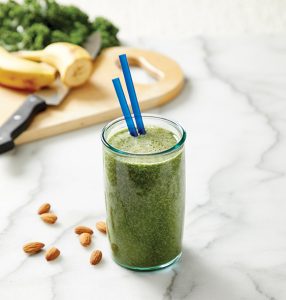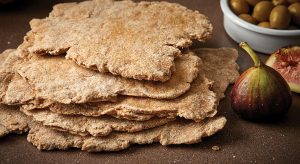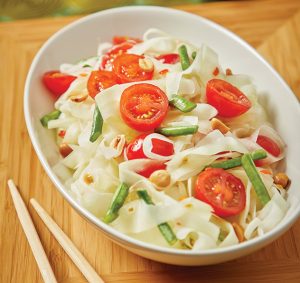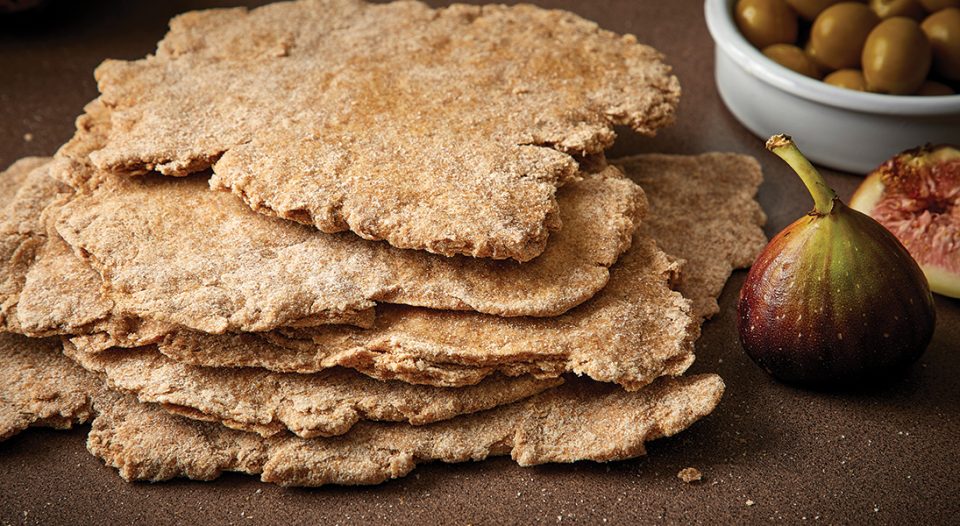For many Lutherans, food and faith are inextricably linked. We gather for a funeral—and a luncheon; a baptism—and reception; a wedding—and a banquet. And we gather around the table in worship to receive the meal that matters most of all, the Lord’s Supper.
Sending manna from heaven, multiplying fish and loaves, Jesus as “the bread of life”—the Bible is rich with food imagery illustrating God’s abundant love for us. It’s no surprise, then, that making and sharing food is one way we express love for each other and our neighbors.
This summer Living Lutheran invited readers to share their favorite recipes—and the faith stories that accompany them—with the wider church.
We selected five recipes and stories to publish in the printed magazine; additional recipes are linked at the end of this article. View the complete collection by clicking the “recipes” tag at the end of this article.
Faithful green smoothie

Faithful green smoothie
By Elaine Hostetler, member of Mount Zion Lutheran Church, LaGrange, Ind.
Can drinking a kale smoothie be an act of faith? Indeed, it can. My morning glass of green goodness (my husband laughingly calls it “pond scum”) helps me to acknowledge the environmental crisis God’s earth faces.
In the U.S., animal feed crops use more than 10 times as many land acres as “people food crops” do (peta.org). I love knowing that I can conserve land resources and thereby support people who are chronically undernourished when I drink this for breakfast.
In addition, my tasty smoothie has many personal benefits: flaxmeal for omega-3 essential fatty acids, turmeric for arthritis relief, almond milk for a bit of protein, kale for fiber, and micronutrients and chocolate for taste.
Pond scum? Bah, humbug! I lovingly raise my glass of green smoothie to God’s people, to God’s earth.
Recipe (serves 1)
Making my smoothie is child’s play: Pour a dash of this, add a scoop of that. No carob? No worries—add more cocoa. No bananas? Substitute strawberries. Don’t have arthritis? Skip the turmeric.
Blend the following ingredients together until thick:
1 cup ice cubes
½ cup water
½ cup almond milk (I make my own by blending a handful of raw almonds, soaked; 1 teaspoon of vanilla; a pinch of salt and 4 cups of water. Strain if you wish.)
2 large kale leaves
1 large banana (the riper, the better)
1 tablespoon flaxmeal
1 teaspoon vanilla
¼ teaspoon turmeric
1 tablespoon cocoa
1 tablespoon carob
Sugar or sweetener to taste (optional)
Widow’s loaves

Widow’s loaves
By Cathy Baca, member of Shepherd of the Hills Lutheran Church, Berkeley, Calif.
I wanted to link Bible stories, healthy food and cooking, so I developed Bible Time Cooking for our day camp at Shepherd of the Hills. Children made recipes related to the Bible lessons taught by their counselors. All the ingredients from these recipes were available during biblical times, and the final products were served as a snack.
This recipe for widow’s loaves is based on the story of Elijah and the widow (1 Kings 17:7-16). God sent Elijah to a widow during a great drought. When he arrived, she was almost out of meal. Elijah said God wanted her to make loaves for him.
Wheat was the favorite grain in biblical households, but barley, rye, spelt, millet, garbanzo beans and lentils were also grown. When wheat ran low, these elements were ground and added to or substituted for flour to make bread. The widow had likely done one of these things to make bread for Elijah.
God saw to it that the widow never ran out of food while the drought lasted. Her bread had enough nutrition to sustain her, her son and Elijah until rains brought a new crop.
Recipe (makes 1 medium loaf or 2 small loaves)
These simple flatbreads are made almost as 1 Kings describes, with only the addition of a bit of salt and some water. Children can even grind whole lentils and millet with a mortar and pestle, if you have one.
½ cup (whole wheat, spelt, millet, garbanzo, lentil or some mixture of these) flour/meal
⅛ teaspoon salt
⅛ cup water
1 tablespoon olive oil
Additional flour or meal for kneading
Mix flour and salt. Mix liquids together and add them to the dry, mixing well.
Put flour or meal on a nonstick surface and turn the dough onto it.
Sprinkle flour/meal on top of the dough, and knead 12 times. (If using flour without gluten this isn’t necessary for rising, but it allows you to work in just enough meal to keep it from being too sticky.)
Form dough into one or two small loaves.
Transfer dough to a cookie sheet and flatten with your hand to about 1/4 inch or so thick.
Bake at 400 degrees for 8 to 10 minutes.
Cool on a wire rack.
Note: These loaves can easily be made gluten-free. If you are cooking with children with gluten sensitivities, be sure all cooking instruments for them are kept separate.
Spirited-filled som-tam

Spirit-filled som-tam
By David Mercurio, member of St. Paul Thai Lutheran Church, Forest Park, Ill.
Piyamat and I started attending St. Paul Thai in 2014 because we wanted to be part of a Christian community where my wife (who was born in Thailand) could hear the gospel in her language and where she would have the opportunity to build friendships with other Thai nationals. Our Thai brothers and sisters have been an absolute blessing from God.
St. Paul was founded as a German Lutheran congregation dating back to the 1800s. After the last descendants either died or moved away, a small band of faithful Christian Thai purchased the building and continued the tradition of living out the gospel. Today, St. Paul Thai’s membership includes Asians, African-Americans and Caucasians.
Every week after our Sunday service, we all move to the social hall where we break bread in fellowship. But instead of breaking bread, we share rice in a potluck of delicious (and often spicy) Thai food. Dinner is then followed by badminton games, singing, guitar playing, English and Thai language lessons, and just great fun.
Recipe (serves 3-4)
1 large green papaya
1 cup of cherry tomatoes
2 long Chinese green beans
1 small cup of peanuts
2 tablespoons of lime juice
1 tablespoon of fish sauce
1 tablespoon of sugar
3 red chili peppers
Peel the papaya and cut into thin strips using a potato peeler.
For the sauce, mix the lime juice, fish sauce and sugar to taste.
Dice the chilis.
Cut the tomatoes into halves.
Mix the papaya strips with the sauce.
Sprinkle the peanuts and tomatoes over the papaya and stir.
Pastor Pete’s pozole

Pastor Pete’s pozole
By Pete Lopez, pastor of St. John Lutheran Church, Angleton, Texas
I am a first-generation American Lutheran but I love my Mexican culture and menu. A favorite food made for our family gatherings is menudo. However, I and other first-generation family members, like my cousins, had difficulty eating it.
In response, my mother and aunts would serve an alternative dish for us. It’s basically menudo with a more palatable substitution named pozole (hominy) because of the corn. Hominy is corn that’s been dried and then soaked in a solution to remove the hull and germ, which causes the kernels to swell.
For 25 years, my wife and I have regularly made this pozole for church potlucks—it’s how we share our culture and stories with others.
Recipe (serves 6)
2 to 3 pounds of cubed pork shoulder
Olive oil for browning
A portion of a container of Fiesta Extra Fancy Menudo Spice Mix (found at grocery stores and/or Amazon)
Salt to taste
2 cans (29 ounce) of white or yellow hominy
A head of lettuce or cabbage
To garnish: Chopped cilantro, chopped yellow onions, juice from a lemon
Optional garnishes: Thin-sliced radishes, sliced lemons/limes, sliced or chopped jalapeños
Begin by browning the cubed pork shoulder in olive oil using a large soup pot so there’s no need to transfer anything.
Once the pork shoulder is browned, add enough water to leave about 3 inches from the top of the pot. When the water comes to a boil, reduce the heat and then let the soup simmer for about an hour.
As the soup simmers, add the menudo mix to color the broth a maroon shade and no more. (The mix is a combination of onion, garlic, chili pepper and other spices, so you don’t want to over-spice it.) Add salt to taste.
At the end of the hour, add all the hominy. Simmer for another half hour.
Shred the head of lettuce or cabbage.
Chop cilantro, onions and any other garnishes.
Serve your pozole in a bowl, leaving room for condiments. Each person adds lemon juice, cilantro and onions to their liking. For more flavors, you can add radishes, lemon/lime slices or jalapeños.
After adding all your elements, the last step is to place the shredded lettuce/cabbage on the very top. This gives the soup a nice crunch. It sounds odd, but it’s a very nice addition. Enjoy!
Seafarer spritz cookies

Seafarer spritz cookies
By Ute Brinkmann, member of Trinity Lutheran Church, New Haven, Conn.
At church they call me the “Cookie Lady” because every week I deliver two containers of homemade cookies to the port chaplain who worships in my congregation. These cookies are for the seafarers in the ports of New Haven and New London in Connecticut.
Today, 1.25 million seafarers go through life largely unnoticed. The ships are docking at our ports and the crew hardly ever gets to set foot on something that doesn’t move—there is little opportunity to reach out to them.
I have been doing this for a couple of years now and wouldn’t miss it for my life. If I am pressed for time during the week, I get up early Sunday morning and make cookies, then deliver my two containers without missing the service.
Baking cookies for people whose nationality and religion I don’t know has become an important part of my life. I have gained many brothers (and maybe a few sisters) whom I will never meet.
Recipe (makes 1 batch of 140 cookies)
1½ cups butter (3 sticks), softened
1 cup sugar
¼ teaspoon salt
2 large eggs, room temperature
1 teaspoon vanilla extract
4 cups flour
Mix the ingredients in the listed order, then form a ball of dough with your hands. (Note: Dough should not stick to fingers.)
Fill cookie press with dough and press cookies onto an ungreased cookie sheet.
Bake at 400 degrees for 10 to 12 minutes.
Transfer the cookies from the hot cookie sheet to a drying rack.
Did you know? Seafarers International House is a mission of the ELCA in which chaplains welcome seafarers and asylum-seekers with pastoral care, hospitality, social assistance, advocacy, prayer—and even cookies. Learn more at sihnyc.org.
Additional reader recipes include:
- Basic pizza crust from Marian Henry
- Chana masala from Lutheran Campus Ministry at the University of Wisconsin-Madison
- Christmas Eve lasagna from Mary Ciccolella
- Coffee cake from Carol Pilmer
- Finnish yogurt cake from Susan Bianchi
- Famous hot milk cake from Carol Burnhenn
- Quick pretzels from Ron Glusenkamp
- Rosettes from Janet Brandsrud
- Shredded Wheat bread from Marit Johnson
- Communion bread from Sondra Sigmon





